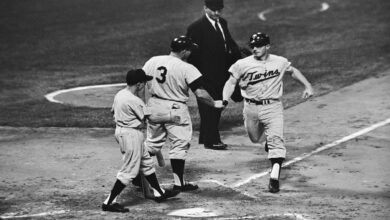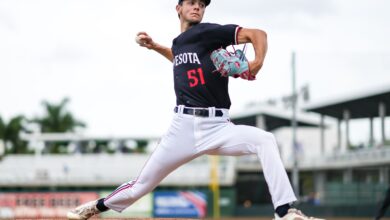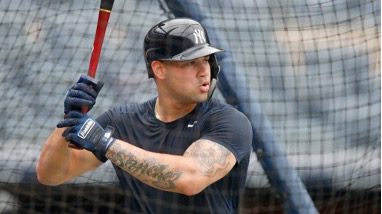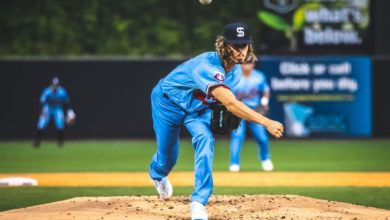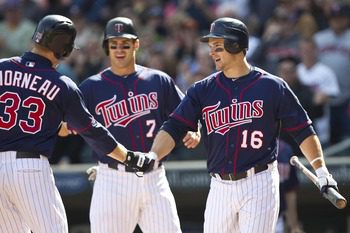
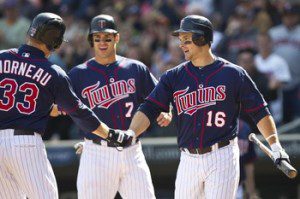
The 2012 Minnesota Twins starting pitchers finished next-to-last in the majors in both ERA and FIP, trailing only the Colorado Rockies. The organization entered the offseason with a clear objective: upgrade the pitching staff system-wide. This objective led the Twins to part with established center fielders Denard Span and Ben Revere for a troika of pitchers — Alex Meyer, Trevor May and Vance Worley. The front office also brought in Mike Pelfrey on a one-year, $5 million deal, signed the oft-injured Rich Harden to a minor-league contract and made a baffling two-year, $10 million commitment to Kevin Correia.
While these pickups undoubtedly leave the staff in a better position than last season, they all come with significant questions. Pelfrey is coming off Tommy John surgery, and despite low-to-mid 90s velocity, has averaged just five strikeouts per nine innings en route to a 4.36 ERA for his career. Worley has had some early career success, but saw his strikeout rate plummet last season, doesn’t have particularly good control and has relied on an almost impossibly high amount of called strikes over his career. Harden is an obvious injury risk. Meyer’s mid-90s fastball and wipeout slider give him top-of-the-rotation potential, but questions about his change-up and control mean he’s more likely to end up in the bullpen. May also possesses a high ceiling, but has major control issues. The less said about Correia the better.
The Minnesota Twins made no major additions to an offense that needed career years from Josh Willingham and Trevor Plouffe just to be average, and they traded away their two best defenders in the search for pitching. Minnesota Twins fans could be in for a long year.
Minnesota Twins position players
Joe Mauer is still Joe Mauer. He’s a good bet to post a .320/.400/.450 line. The question here is can he do that and catch 100 games or more? Ryan Doumit can hit a little bit and pretends to catch. It’s sure more fun to see him in the lineup than Drew Butera, but it’s tough to think he’s an overall improvement considering his poor defense.
Outside of Mauer, it looks ugly. Justin Morneau is a shell of his former self at first base, though, to the extent that spring training talk can be trusted (pretty much zero), he seems to be feeling better than he has since concussions and back issues derailed his career in mid-2010. The revolving door at the middle infield spots looks like it will continue. Pedro Florimon, Brian Dozier, Jamey Carroll and Eduardo Escobar will all see time. Carroll, despite being the best option, which is quite sad in and of itself, will play a utility role behind Florimon and Dozier. While all of these guys (besides possibly Dozier) are good bets to be solid defenders, none of them are likely to be even league-average hitters.
Plouffe will attempt to prove that most of his career has been a fluke, and that the real Plouffe is the guy we saw last June. His power is real, but it’s tough to envision him cracking a .260 average or .320 OBP. Combine that with his stone hands and erratic throws, and you’ve got a guy who’s no more than a useful platoon/bench bat. Like Plouffe, Chris Parmelee killed the majors for a month, destroyed triple-A for a couple months and was seriously mediocre in the several years leading up to that. Like Plouffe, he’s also a terrible defender, both in the outfield and at first base. He might be an average big-league hitter, but that won’t be enough to stomach his poor defense in right or to warrant playing him at first.
Willingham can hit, and his pull-happy style fits very well in Target Field. He’ll probably be the second-best hitter on this squad, but it’s doubtful he can match last year’s career year at age 34. Like Parmelee, he also struggles defensively.
Prospect Aaron Hicks, 23, is going to fill center field in the wake of the Span and Revere trades. Hicks is an excellent athlete and an exciting prospect who impressed in spring training. However, he’s never played above double-A, has a history of starting slowly at new levels and has had major strikeout issues. His patience has been an asset, and it’ll be interesting to see if that translates to the majors considering his lack of power. Hicks should be a very good defender in center, but it’ll probably be a year or two before he hits.
Minnesota Twins pitching
It can’t get any worse than last year, right? It’s nearly impossible to imagine things going worse than last year for the Minnesota Twins starters. I ask you to allow me, if you will, to try.
Coming into 2012, there were a few glimmers of hope. Squinting at Francisco Liriano, it was possible to see a decent pitcher. Scott Baker, before going under the knife, had always produced above-average results and been downright excellent before getting hurt in 2011. Carl Pavano had been a solid, average hoss for two years in a row. Liam Hendriks retained a bit of prospecty shine. It didn’t look great, but at least there was something to dream on.
The rotation coming into 2013 features Vance Worley and Scott Diamond (Diamond will start the season on the DL, but hopefully will be back by the end of April) as the de facto one and two starters. Both had offseason surgery and both are huge candidates for regression. Diamond posted groundball and walk rates far better than anything his minor-league track record suggested. Worley struggled last season, and it won’t get any easier as he transitions to the American League.
Pelfrey looks to be a solid mid-rotation option for the Minnesota Twins, but he’s returning from Tommy John surgery, so expectations are tempered. Hendriks, who has been excellent at every level in the minors, will probably get a shot to stick this season, though his previous major-league stints have been extremely underwhelming. It looks like Cole DeVries will fill the fifth spot with gopherballs until Diamond returns from the DL. World Baseball Classic hero Sam Deduno will provide depth along with prospect Kyle Gibson, who should be up to stay by midseason.
There’s almost no way the rotation can equal last season’s incompetence, but it’s also really hard to expect the Minnesota Twins to be any better than the bottom third of the majors.
Minnesota Twins projected lineup
- Aaron Hicks CF
- Brian Dozier 2B
- Joe Mauer C
- Justin Morneau 1B
- Josh Willingham LF
- Ryan Doumit DH
- Trevor Plouffe 3B
- Chris Parmelee RF
- Pedro Florimon SS
Minnesota Twins prospect watch
Hicks will be the opening day center fielder and should provide excellent defense right away. His bat might be a year or two away from making an impact, but he should be an exciting tablesetter for the foreseeable future. If Parmelee falters in right, or Morneau or Willingham is moved at the deadline, look for Oswaldo Arcia, who has mashed at every level, to fill a corner outfield spot. Other heralded prospects such as Miguel Sano, Eddie Rosario, Max Kepler and Byron Buxton are all a year or more away.
On the mound, RHP Kyle Gibson will be limited to around 140 innings but should see most of those in the major leagues. Despite a slow spring, he might be the best pitcher in the organization right now. New acquisition May could see bullpen time in the latter half of the year, as could 6’-7” righty Michael Tonkin. Depending on innings limits, we could also see Meyer in a late relief role in September.
Prediction
This is another rebuilding year, so Minnesota Twins fans should be looking for small victories. Do young guys like Parmelee, Dozier and Hendriks make strides? Can Plouffe prove last June wasn’t a fluke? Can Hicks, Gibson and Arcia impress in their debuts? Can Mauer stick for 100+ games behind the plate? Will Morneau return to form? If the team stays healthy, the youth should provide enough excitement to at least make the team watchable.
Record-wise, the best you can hope for is 75 wins, but to me, this season will be a success if all the young talent takes a step forward. The Minnesota Twins are building toward 2014 and beyond, and they’ve got real impact talent on the farm for the first time in years.


